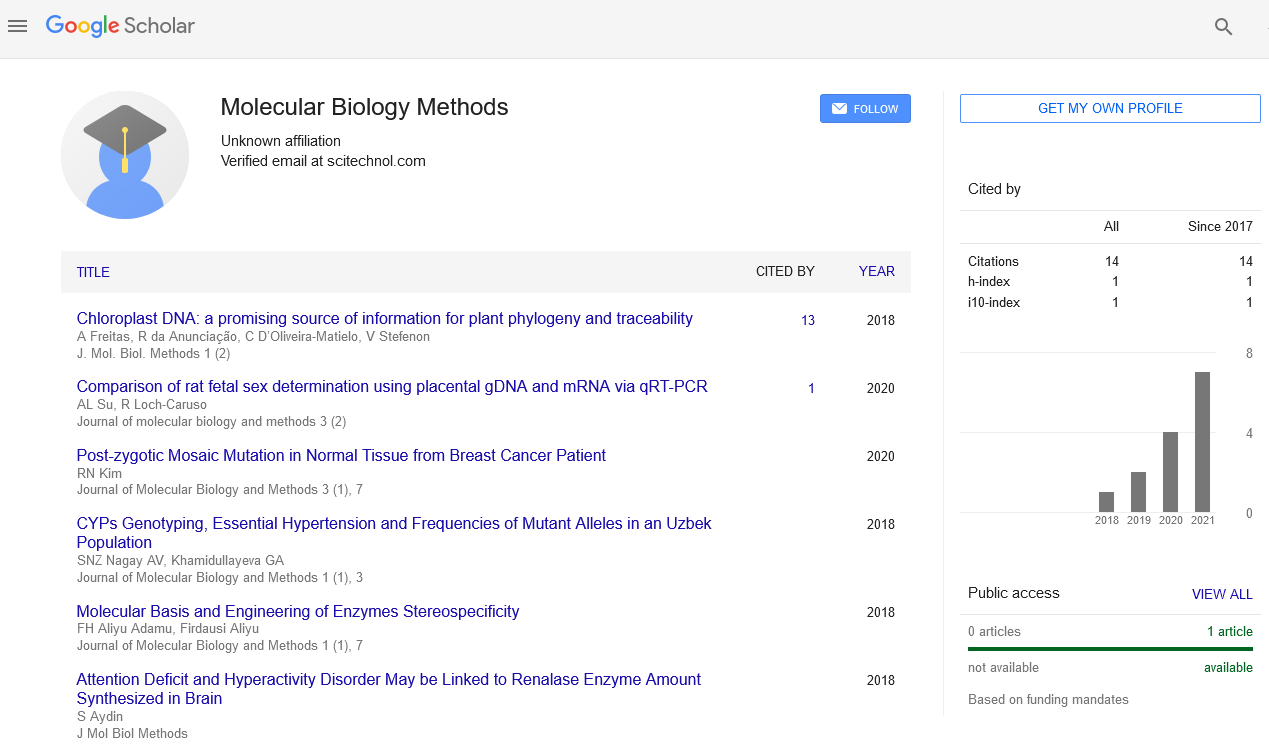Short Communication, J Mol Biol Methods Vol: 7 Issue: 4
Recombinant DNA Technology: The Secrets of Genetic Engineering
Wagner Adele*
1Department of Biology, University of Haifa, Haifa, Israel
*Corresponding Author: Wagner Adele,
Department of Biology, University of
Haifa, Haifa, Israel
E-mail: wagneradele@gmail.il
Received date: 25 November, 2024, Manuscript No. JMBM-24-154478;
Editor assigned date: 28 November, 2024, PreQC No. JMBM-24-154478 (PQ);
Reviewed date: 12 December, 2024, QC No. JMBM-24-154478;
Revised date: 19 December, 2024, Manuscript No. JMBM-24-154478 (R);
Published date: 26 December, 2024 DOI: 10.4172/JMBM.1000185
Citation: Adele W (2024) Recombinant DNA Technology: The Secrets of Genetic Engineering. J Mol Biol Methods 7:4.
Description
Recombinant DNA (rDNA) technology, also referred to as genetic engineering, is one of the most important advancements in modern biology. This technology involves the manipulation of an organism's genetic material by combining DNA from different sources, creating new genetic combinations that would not naturally occur. By enabling the transfer of specific genes between organisms, recombinant DNA technology has led to significant advances in medicine, agriculture and biotechnology. It is a powerful tool that has reshaped scientific research and practical applications across a wide range of fields [1].
The foundation of recombinant DNA technology lies in the ability to isolate and manipulate the genetic material (DNA) of an organism. DNA is composed of two long chains of nucleotides that form a double helix structure, with the sequence of these nucleotides encoding genetic information [2]. The process of recombinant DNA technology begins with the extraction of DNA from the organism of interest. Once isolated, specific genes can be cut out of the DNA using special enzymes known as restriction endonucleases or simply restriction enzymes [3]. These enzymes act like molecular scissors, recognizing and cutting DNA at specific sequences. This allows scientists to isolate genes with great precision, an important step in the process of genetic modification [4-6].
After isolating the desired gene, it is inserted into a vector, which is usually a plasmid or a viral DNA molecule. Plasmids are small, circular DNA molecules that are commonly found in bacteria. Vectors serve as carriers for the gene of interest, transporting it into a host cell. Once the gene is inserted into the vector, the recombinant DNA molecule is introduced into a host organism, often a bacterium, yeast, or even a mammalian cell, through a process called transformation or transfection [7]. The host organism then expresses the foreign gene, producing the corresponding protein or enzyme encoded by that gene. This allows researchers to study gene function, produce large quantities of proteins, or even modify the host organism's traits.
One of the key components of recombinant DNA technology is the ability to select and screen for successful transformations [8]. Not every host cell will successfully incorporate the recombinant DNA, so scientists use markers, such as antibiotic resistance genes, to identify and select transformed cells. For example, if a plasmid containing a gene for antibiotic resistance is introduced into bacteria along with the gene of interest, only the bacteria that have successfully incorporated the plasmid will survive when exposed to the antibiotic. This allows researchers to isolate and study the transformed organisms that carry the new genetic material [9].
Another important medical application of recombinant DNA technology is the development of vaccines. Recombinant vaccines are made by inserting genes from pathogens (viruses or bacteria) into a host organism, such as yeast or bacteria. These organisms then produce the pathogen's proteins, which are used to stimulate an immune response in the body without causing disease [10]. The hepatitis B vaccine, for instance, is produced using recombinant DNA technology by inserting the gene for a hepatitis B virus protein into yeast cells. The yeast then produces the protein, which is purified and used as a vaccine to protect against the virus.
Conclusion
In conclusion, recombinant DNA technology has transformed the way we approach biological research, medicine, agriculture and biotechnology. Its ability to manipulate and modify genetic material has led to the creation of new therapeutic products, genetically modified crops and industrial processes that were once unimaginable. While there are ongoing concerns regarding its ethical and environmental impacts, the technology continues to hold immense promise for addressing some of the world’s most pressing challenges. As our understanding of genetics advances, recombinant DNA technology will likely continue to evolve, unlocking new possibilities in science and medicine.
References
- Graham FL, Van Der Eb AJ (1973) A new technique for the assay of infectivity of human adenovirus 5 DNA. Virol. 52(2):456-467.
- Neumann E, Schaefer‐Ridder M, Wang Y, Hofschneider P (1982) Gene transfer into mouse lyoma cells by electroporation in high electric fields. EMBO J. 1(7):841-845.
- Crick F (1970) Central dogma of molecular biology. Nat. 227(5258):561-563.
- Naldini L, Blömer U, Gallay P, Ory D, Mulligan R, et al. (1996) In vivo gene delivery and stable transduction of nondividing cells by a lentiviral vector. Sci. 272(5259):263-267.
- Kucherlapati RS, Eves EM, Song KY, Morse BS, Smithies O (1984) Homologous recombination between plasmids in mammalian cells can be enhanced by treatment of input DNA. Proc Natl Acad Sci. 81(10):3153-3157.
- Thomas KR, Capecchi MR (1987) Site-directed mutagenesis by gene targeting in mouse embryo-derived stem cells. Cell. 51(3):503-512.
- Mansour SL, Thomas KR, Capecchi MR (1988) Disruption of the proto-oncogene int-2 in mouse embryo-derived stem cells: A general strategy for targeting mutations to non-selectable genes. Nature. 336(6197):348-352.
- Auwerx J, Avner P, Baldock R, Ballabio A, Balling R, et al. (2004) The European dimension for the mouse genome mutagenesis program. Nature Genet. 36(9):925.
- Collins FS, Rossant J, Wurst W (2007) A mouse for all reasons. Cell. 128(1):9-13.
- Skarnes WC, Rosen B, West AP, Koutsourakis M, Bushell W, et al. (2011) A conditional knockout resource for the genome-wide study of mouse gene function. Nat. 474(7351):337-342.
 Spanish
Spanish  Chinese
Chinese  Russian
Russian  German
German  French
French  Japanese
Japanese  Portuguese
Portuguese  Hindi
Hindi 